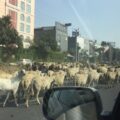It is the last day of 2016, and I have committed myself to a 4 am wake-up call. To add context, I am more sunset than a sunrise kind of person. So early mornings have to be worthwhile.
In this case, it was a jeep ride into one of the most extensive grasslands in Asia, the Banni Grasslands in Kutch. Located about 85kms from Bhuj, they spread over 2500 square kilometers and host a wide variety of animals, reptiles, and birds. In winters, it becomes a watering hole for migratory birds from as far away as Scandinavia.
Knowing that a place like this existed, in what is largely a semi-arid desert, sleepless nights were a given, and an early morning call didn’t seem as taxing.

On the edge of the Banni grasslands is the Chhari-Dhand Wetland Conservation Reserve, a rarely visited gem in the Rann of Kutch. Since Chhari-Dhand lies at a slight depression, it can retain the moisture from the scanty rainfall longer, making it conducive for migratory birds.
I was particularly interested in the cranes, which I was informed, come here to feed on the tuberous roots of nutsedge. And the Flamingoes, which are said to get their pink-hued coats owing to the alkalinity in the shallow waters. It is a paradise for bird-watchers, photography enthusiasts and ornithologists.
Notwithstanding your relation with the birds and animals, merely being in the stillness of nature and one with the vastness of the Rann, without a soul in sight, gives a different kind of high.

Having experienced the bustle of the Rann Utsav earlier in our trip, my two friends and I wanted to wind up our holiday, and the year, with something quieter. We choose Rann Visamo, set outside the village of Hoodka, as our rural retreat. The accommodation here is a mix of tents, cottages, and traditional Bhungas.
It is the closest you can come to a Kutchi village lifestyle, as the resort is made entirely of mud, including its boundary walls and seating areas. The traditional Bhunga remains the star attraction. A circular mud structure crowned with a conical wooden/thatched roof and decorated with intricate mirror work, both on the inside and outside.
Although the overriding theme is rural, most modern amenities like comfortable beds with warm blankets, mosquito nets, electric fans, and bathrooms with western toilets make the stay comfortable.

The meal here is a simple vegetarian fare featuring Bajra-ki-roti, dals (lentils), an assortment of green vegetables, and kadhi with khichari. The perfect antidote to the heat, chaas (buttermilk), is served at the end of every meal.
When I enquired with Harish Bhai, the man who ran the show here, about visiting the Chhari Dhand he couldn’t hide the surprise in his voice. ‘Not many visitors come here for that,’ he said – mainly because most of them do not know about its existence!
Since it was a last-minute request, he couldn’t arrange a professional guide to accompany us but found us a local with exceptional navigational skills to drive us there. Given the terrain and the fact that tracing your tyre tracks is the only way back, his presence was greatly appreciated.

Finally, on a cold misty morning, we climbed into the rickety jeep wrapped in all the woolens we had carried and set out to explore the vast expanse of the marshy land of Chhari Dhand. We made our way through the eerie silence of the darkness, broken only by the constant humming of the jeep’s engine. None of us spoke for the next one-hour.
After a while, the jeep veered off the main road heading into the dirt track and through the parched land. This is where our driver-cum-guide, Salim Bhai’s navigational skills came in quite handy. It is easy to get lost in this vast emptiness with hardly any markers for directions. With his help, we made it inside, just in time to witness a spectacular sunrise.

The land was bathed in light golden hues as we drove towards the concrete tower, which though an eyesore, commanded great views over the landscape. As the sun glimmered and the mist began to clear, we were able to fathom the enormity of this marshy land. Gazing at the nothingness and yet having a sense of fulfillment was a peculiar juxtaposition of feelings one felt here.
From the time the first rays of the sun hit the ground until the mist completely disappeared, the land had transformed. The pitch darkness gave way to silhouettes of shrubs and animals. The tranquility of the night gave way to the chirping of the birds. Nature was waking up, and we were there to witness it!

Sipping the camel milk infused tea, generously offered by the local Rabari tribesmen, we realized the place is not so desolate after all. These nomadic tribes call this land home for a few months in a year when they bring their livestock to graze on the grasslands. With their frilly shirts, dhoti’s, and colorful turbans, they exuded a humble charm.
Although their language was difficult to follow, their eyes spoke of the reverence they had for this barren land. The land that provided them their livelihood.
On our way back, I took to the wheels. Albeit for a brief period, I felt liberated. With no rules to abide by or directions to follow, it was the land and I. Unfiltered and unadulterated, that moment made the 4 am wakeup call worth it.

Photos: Author, Unsplash and Pixabay






1 Comment
Saanvi
Kutch seems like a beautiful place, I will definitely plan a trip there soon!